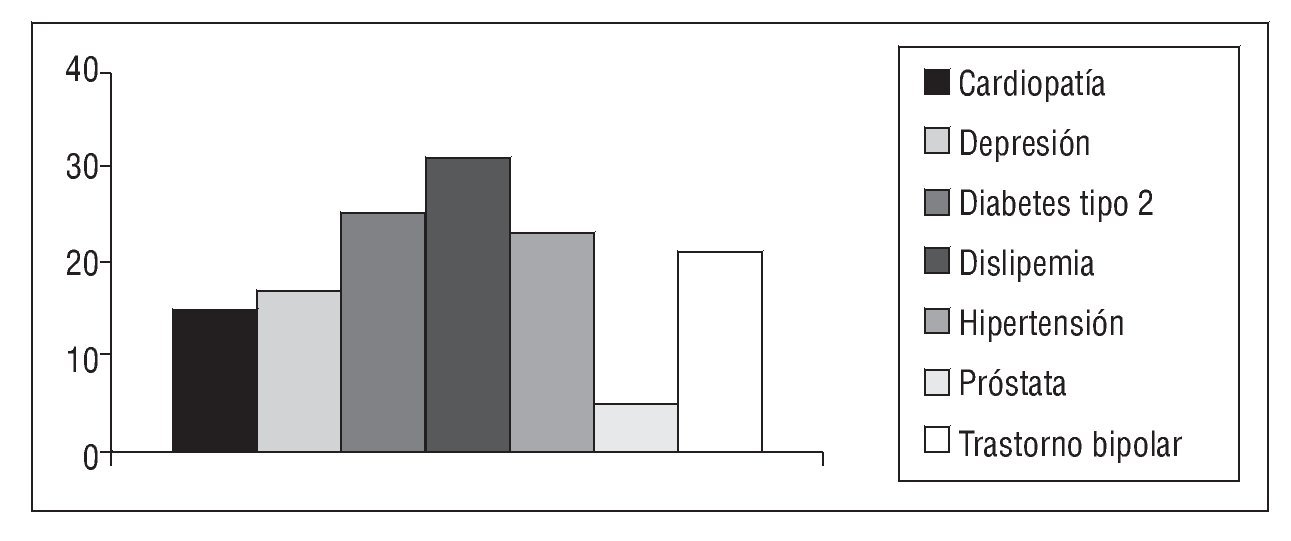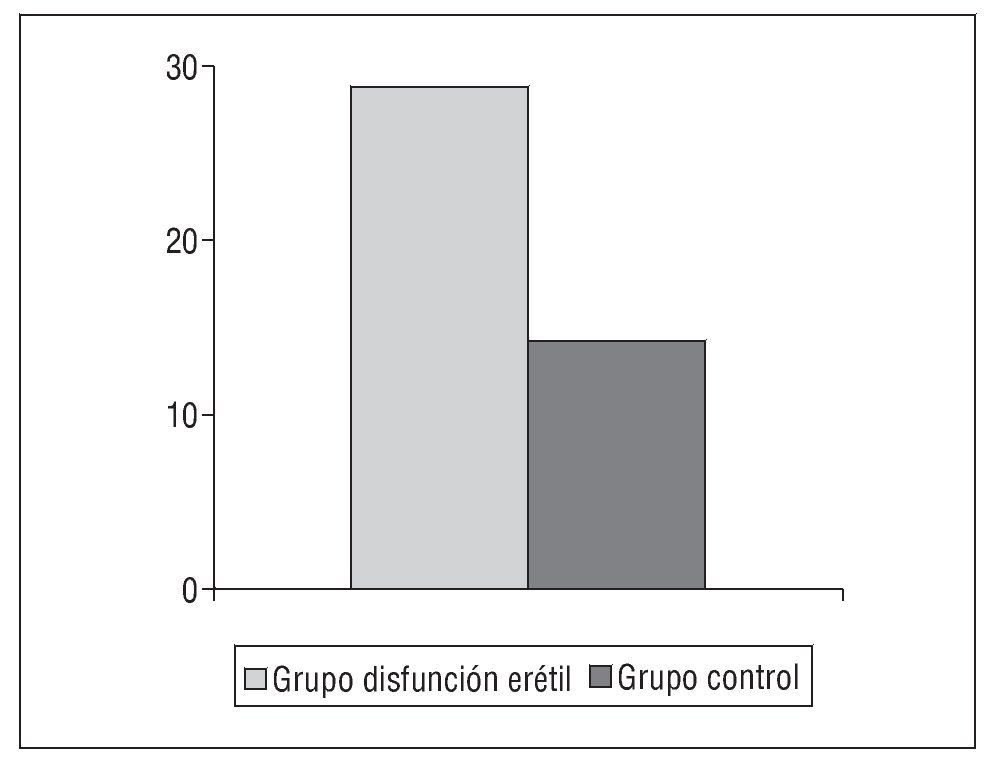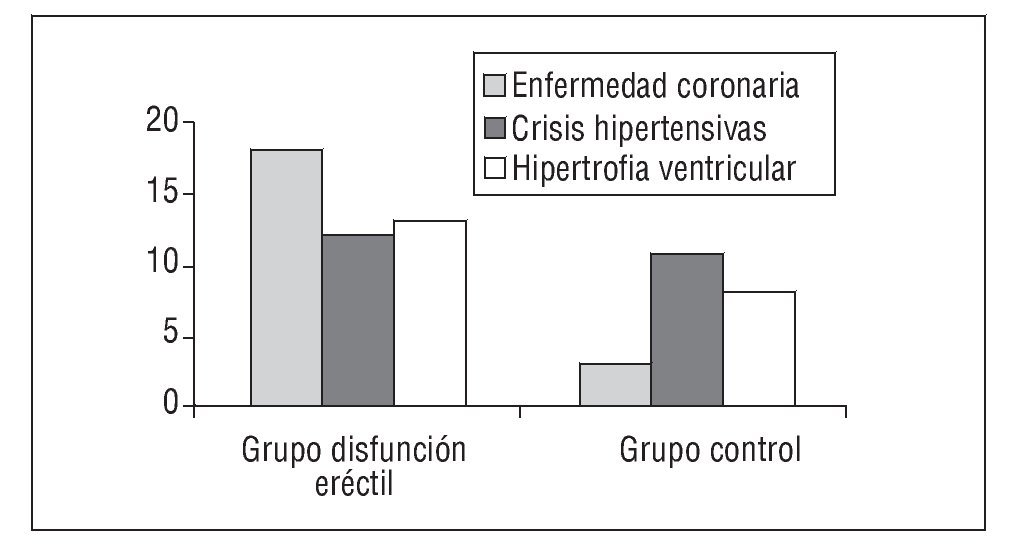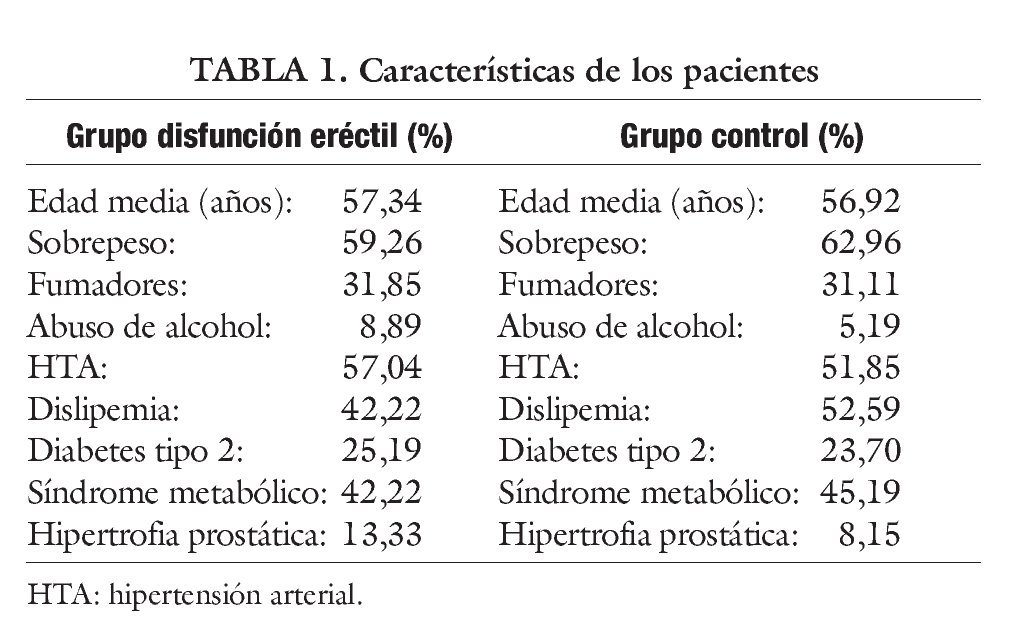Journal Information
Vol. 6. Issue 1.
Pages 18-22 (January 2008)
Vol. 6. Issue 1.
Pages 18-22 (January 2008)
Disfunción eréctil: de marcador de salud a factor de riesgo cardiovascular independiente en atención primaria
Erectile dysfunction: a health marker of an independent cardiovascular risk factor
Visits
2309
Lorenzo Guirao Sáncheza, Luis García-Giralda Ruizb, Isabel Casas Arandab, Juan Vicente Alfaro Gonzálezc, Gregorio Antonio Sánchez Pérezd, Antonio Piñera Guiraoe, Concepción Sandoval Martíneza
a Centro de Salud de Alguazas. Gerencia de Atención Primaria de Murcia. SMS. Murcia. España.
b Centro de Salud Murcia-Centro. Gerencia de Atención Primaria de Murcia. SMS. Murcia. España.
c Centro de Salud de Archena. Gerencia de Atención Primaria de Murcia. SMS. Murcia. España.
d Consultorio Simón García. Gerencia de Atención Primaria de Murcia. SMS. Murcia. España.
e Facultad de Medicina. Universidad de Murcia. Murcia. España.
This item has received
Article information
Objetivo: Analizar datos de estudios donde se propone la disfunción eréctil (DE) como marcador del estado de salud, y sobre su implicación como factor de riesgo cardiovascular independiente. Método: Se comparan resultados del estudio APLAUDE (2002) con los más recientes del grupo de trabajo AIDS-AP (2006) sobre DE como factor de riesgo cardiovascular independiente (FRVC-i). Resultados: La DE se mostró como marcador del estado de salud al detectar patologías relevantes desconocidas: dislipemia (27,3%), diabetes mellitus (22%), hipertensión arterial (20,4%), síndrome ansioso (18,5%) y/o depresivo (14,6%) y patología prostática (4%); pudiendo presentar más de una de ellas simultáneamente. Como FRCV-i, el porcentaje de pacientes con resultado patológico ha sido del 28,89% (39) en el grupo DE, muy superior al grupo control, 14,07% (19) (p < 0,001). Las patologías detectadas a través de la ergometría y la ecocardiografía de estrés han sido: 18 pacientes (13,3%) con enfermedad coronaria en el grupo DE y 3 (2,22%) en el grupo control (p < 0,001), 12 crisis hipertensivas (8,89%) en el grupo DE y 11 (8,15%) en el grupo control (no significativa), y 13 (9,63%) hipertrofias de ventrículo izquierdo en el grupo DE y 8 (5,93%) en el grupo control (p < 0,01). Conclusiones: Los resultados sugieren una relación muy estrecha entre FRCV y DE, e indican que los pacientes con DE presentan cardiopatía isquémica silente en una proporción muy superior a los otros pacientes con perfil similar pero que no tienen DE, por lo que proponemos considerarla como un FRCV-i.
Palabras clave:
Disfunción eréctil
Marcador de salud
Factor de riesgo cardiovascular independiente
Objective: The objective of this research is to analyze data from researches where erectile dysfunction (ED) is proposed as a health marker, as well as data about its involvements as independent cardiovascular risk factor. Method: The results of the APLAUDE research (2001) are compared with the more recent ones of the AIDS-AP group (2006), both about ED as independent cardiovascular risk factor (i-CVRF). Results: ED was considered to be a health marker when detecting relevant unknown diseases: dyslipidemy (27.3%), diabetes mellitus (22%), HTN (20.4%), anxiety (18.5%) and/or depression (14.6%) and prostate disease (4%); or even several of them at the same time. As i-CVRF, the percentage of patients with pathological results was 28.89% (39) in the ED group, much higher than in the control group, 14.07% (19) (p < 0.001). This were the diseases detected with ergometry and stress echocardiography: 18 patients (13.3%) with coronary heart disease in the ED group and 3 (2.22%) in the control group (p < 0.001), 12 hypertensive attack (8.89%) in the ED group and 11 (8.15%) in the control group (NS), and 13 (9.63%) with right ventricle hypertrophy in the ED group and 8 (5.93%) in the control group (p < 0.01). Conclusions: The results suggest a very close relationship between CVRF and ED, and show that patients with erectile dysfunction have silent ischemic cardiopathy in a much higher percentage than patients with similar profile but without erectile dysfunction, so we can consider ED as an i-CVRF.
Keywords:
Erectile dysfunction
Health marker
Independent cardiovascular risk factor
These are the options to access the full texts of the publication Revista Internacional de Andrología
Subscriber
Purchase
Contact
Phone for subscriptions and reporting of errors
From Monday to Friday from 9 a.m. to 6 p.m. (GMT + 1) except for the months of July and August which will be from 9 a.m. to 3 p.m.
Calls from Spain
932 415 960
Calls from outside Spain
+34 932 415 960
E-mail







